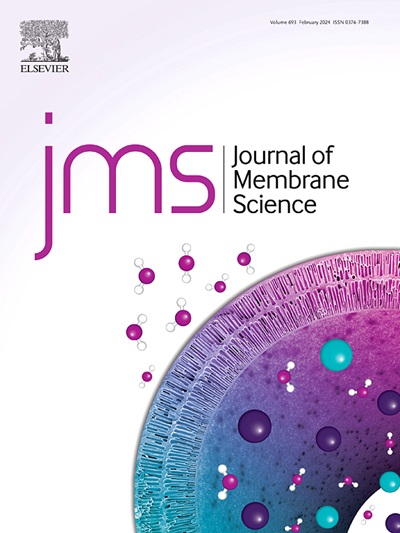Tuning polyelectrolyte topology and crosslinking parameters to facilitate same-sized monovalent nutrient ions separation
IF 9
1区 工程技术
Q1 ENGINEERING, CHEMICAL
引用次数: 0
Abstract
This work focuses on developing a novel nanofiltration membrane platform for separating two same sized monovalent nutrient ions – NH4+ and K+ under neutral pH condition. NH4+ and K+ are two critical fertilizer raw materials and achieving selective separation between them would offer the flexibility to tune the nutrient (N:K) ratio, enabling a final product suitable for diverse fertilizer applications. Separation of NH4+ and K+ is intrinsically challenging, since the hydrated radii of both NH4+ and K+ are identical (0.33 nm) with slight difference in hydration energy (∼10 kJ/mol) between them. In this work, a series of polyelectrolyte modified membranes based on linear and branched polyelectrolytes and crosslinked using different crosslinking parameters (e.g. crosslinker type and concentration, duration of crosslinking etc.) were developed and tested. These membranes showed a broad range of NH4+/K+ separation performance in terms of NH4+ permeance and NH4+/K+ selectivity, depending on an ion desolvation based separation mechanism. A novel hybrid polyelectrolyte combination consisting of a 1:1 weight ratio of linear (poly allylamine hydrochloride, (PAH) and a branched polyethyleneimine (,PEI)) polycation was further investigated. This configuration, when combined with a polyanion (polyacrylic acid or, PAA) into a 5.5 bilayered uncrosslinked system showed the highest NH4+ passage (i.e. lowest NH4+ rejection ∼10 %) among all polyelectrolyte systems. The hybrid PAH:PEI configuration when simply deposited as a single layer (without PAA) on the NF 270 membrane and crosslinked with Glutaraldehyde (GA), showed the highest NH4+/K+ selectivity (>2.5) among all systems. A careful analysis of these various systems indicate that the topologies of the polyelectrolytes (e.g. linear vs. branched polycation and molecular weights) play a pivotal role in the overall NH4+/K+ separation performance, in conjunction with other important factors such as crosslinking density, polyelectrolyte molecular weight, etc. The best performing 1-layered crosslinked hybrid polyelectrolyte system was also tested with a quaternary ion mixture consisting of 4 similar-sized monovalent ions (Li+, Na+, NH4+ and K+). A desolvation based phenomenon, which is aided by the creation of confinement domains by branched polyelectrolytes and polyelectrolyte crosslinking, has been hypothesized to be the primary separation mechanism for the same-sized NH4+ and K+ ions. This study therefore presents a fundamental framework for designing nanofiltration membranes through surface-modifications to achieve selective separation between same-sized and similar sized ions.

调整聚电解质拓扑结构和交联参数,以促进相同尺寸的单价营养离子分离
在中性pH条件下,开发了一种新型纳滤膜平台,用于分离两种相同大小的单价营养离子- NH4+和K+。NH4+和K+是两种关键的肥料原料,实现它们之间的选择性分离将提供调整养分(N:K)比例的灵活性,使最终产品适合不同的肥料应用。NH4+和K+的水化半径相同(0.33 nm),水化能相差不大(~ 10 kJ/mol),因此分离NH4+和K+具有很大的挑战性。本文以线性和支链聚电解质为基础,通过不同的交联参数(如交联剂的种类、浓度、交联时间等)进行交联,研制并测试了一系列聚电解质改性膜。这些膜在NH4+渗透和NH4+/K+选择性方面表现出广泛的NH4+/K+分离性能,这取决于基于离子脱溶的分离机制。进一步研究了一种由线性聚丙烯胺盐酸盐(PAH)和支链聚乙烯亚胺(PEI))组成的重量比为1:1的新型杂化聚电解质组合。当这种结构与聚阴离子(聚丙烯酸或PAA)结合成5.5双层非交联体系时,在所有聚电解质体系中显示出最高的NH4+通过(即最低的NH4+截除率~ 10%)。混合PAH:PEI结构在NF 270膜上沉积单层(不含PAA)并与戊二醛(GA)交联时,表现出最高的NH4+/K+选择性(>2.5)。对这些不同体系的仔细分析表明,聚电解质的拓扑结构(如线性与支链聚阳离子和分子量)与交联密度、聚电解质分子量等其他重要因素一起,对NH4+/K+的整体分离性能起着关键作用。用由4个大小相近的一价离子(Li+、Na+、NH4+和K+)组成的季离子混合物测试了性能最佳的1层交联杂化多电解质体系。支化聚电解质和聚电解质交联产生约束域的脱溶现象被假设为相同大小的NH4+和K+离子的主要分离机制。因此,本研究提出了通过表面修饰设计纳滤膜的基本框架,以实现相同大小和相似大小离子之间的选择性分离。
本文章由计算机程序翻译,如有差异,请以英文原文为准。
求助全文
约1分钟内获得全文
求助全文
来源期刊

Journal of Membrane Science
工程技术-高分子科学
CiteScore
17.10
自引率
17.90%
发文量
1031
审稿时长
2.5 months
期刊介绍:
The Journal of Membrane Science is a publication that focuses on membrane systems and is aimed at academic and industrial chemists, chemical engineers, materials scientists, and membranologists. It publishes original research and reviews on various aspects of membrane transport, membrane formation/structure, fouling, module/process design, and processes/applications. The journal primarily focuses on the structure, function, and performance of non-biological membranes but also includes papers that relate to biological membranes. The Journal of Membrane Science publishes Full Text Papers, State-of-the-Art Reviews, Letters to the Editor, and Perspectives.
 求助内容:
求助内容: 应助结果提醒方式:
应助结果提醒方式:


